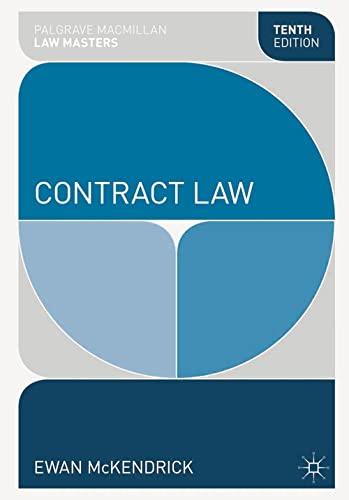Question
The group to analyse the following law case in respect of its issues, solution for each issue, and the reasons for the solutions made: The
The group to analyse the following law case in respect of its issues, solution for each issue, and the reasons for the solutions made:
The Plaintiffs, comprising of a group of some twenty-three (23) consultants from various disciplines in the construction industry, were involved in the setting up and construction of a second campus for the Defendant, Universiti Teknologi MARA ("UiTM"). The Plaintiffs claimed they had rendered consultancy services in respect of the property for which they were yet to be paid. This was denied by the Defendant who took the position that it had no privity of contract with any of the Plaintiffs; that the claim was time-barred; that the Plaintiffs in any case had been paid for services rendered; and that there was no loss proved. The Defendant appointed AS Contractor as the main contractor for the said project. AS Contractor then had appointed the Plaintiff as the main consultant vide Lead Consultant's Agreement on 23 September 2002. The Plaintiff appointed and engaged the services of several consultants to assist the Plaintiff in the completion of the project via various sub consultant agreements. The Plaintiff was to be paid once AS Contractor was paid. The Plaintiff was to be paid 100% of the consultancy fee upon settlement of the final accounts between AS Contractor and the Defendant. This arrangement however did not come to pass. It was subsequently decided that the project would be implemented in phases. For that, the Defendant and AS Contractor entered into 3 separate formal contracts based on JKR Standard Form of Design & Build/Turnkey Contract (PWD Form DB/T edisi 2002). The contracts related to the construction of the infrastructure works for Satellite A and B. None of those contracts involved Satellite C. Subsequently, the remainder of the project was implemented using a different mechanism awarded to parties that did not involve the Plaintiff. This meant that the Plaintiff would not be paid full fees. The Plaintiff thus approached the Defendant for payment and the Defendant took the position that it did not owe the Plaintiff for the simple reason that there was no contractual relationship between itself and the Plaintiff. The Plaintiff thus filed the present claim. The issues arising for determination were: (1) whether there was a legally binding contract between the Plaintiff and the Defendant; and (ii) whether the Plaintiff was entitled to claim herein against the Defendant for all works completed pursuant to Section 71 of the Contract Act 1950.
Step by Step Solution
There are 3 Steps involved in it
Step: 1

Get Instant Access to Expert-Tailored Solutions
See step-by-step solutions with expert insights and AI powered tools for academic success
Step: 2

Step: 3

Ace Your Homework with AI
Get the answers you need in no time with our AI-driven, step-by-step assistance
Get Started


